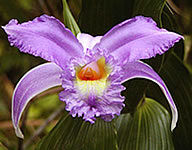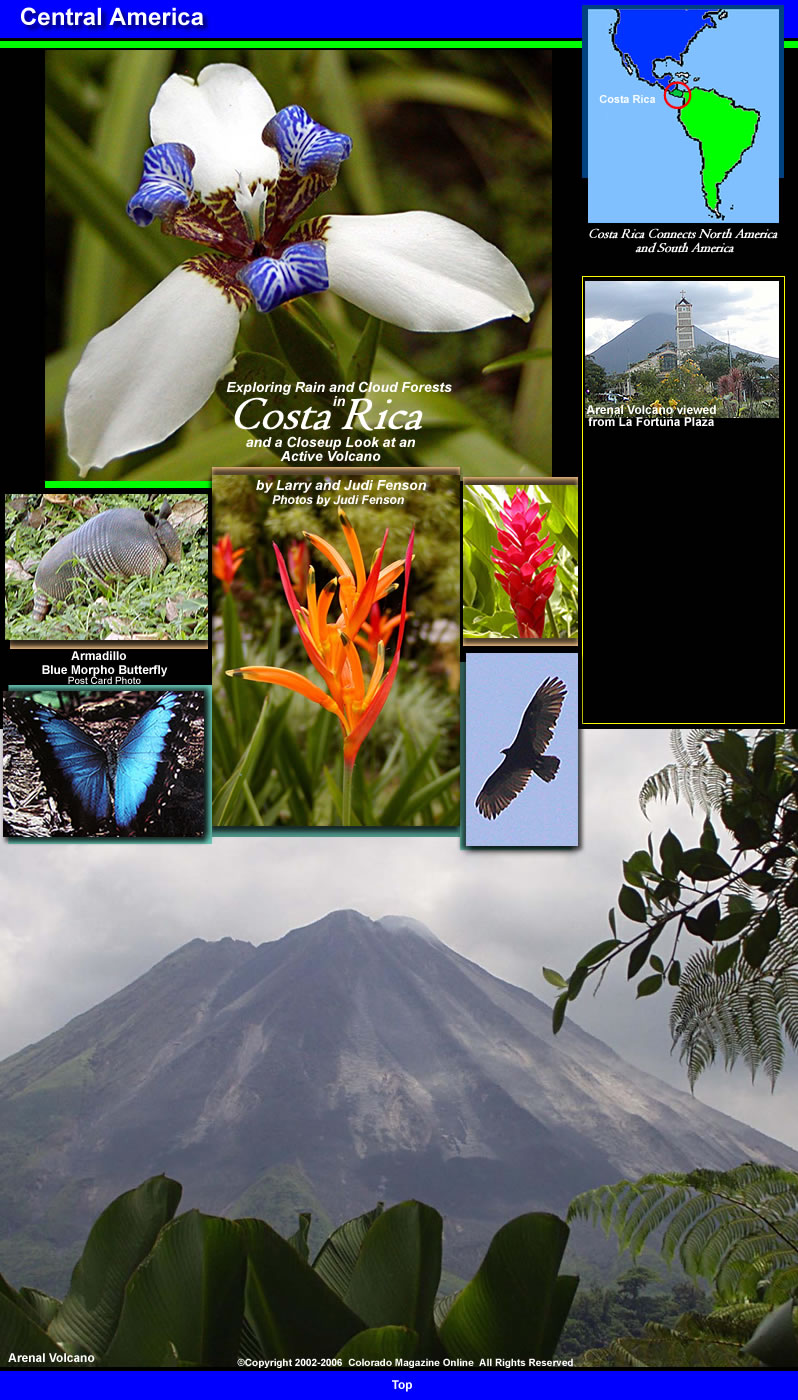March 30 to April 6, 2005
Trip to Costa Rica
We had never really been motivated to visit Costa Rica because we prefer places that are more off the beaten path. Then about 9 months ago Larry read a short article on places offering the best opportunity to see active volcanoes. The most active volcano is in Hawaii. Another is Arenal in Costa Rica. The third might be Popocatelpetl in Mexico.
We had previously seen three other active volcanoes. One was when we flew over Montserrat in 1997 on the way to Dominica. It was incredible to see the total devastation on the half of the island that lay in the path of the massive lava flow - and it was still smoking vigorously. A second was in Banos, Ecuador in 2003. Tungurahura had violently erupted about 18 months earlier, prompting a complete mandatory evacuation of Banos. The volcano was smoking when we saw it and it was quite a sight. A third was in Papua New Guinea on Manam Island at the mouth of the Sepik River.
Volcanoes account for some of the most impressive sights we have seen in our travels. Some of the best are along the section of the Pan American highway south of Quito called the "Avenue of the Volcanoes" in Ecuador. Snowed-capped Cotapaxi at about 21,000 ft. and several others are just awe-inspiring. So is Imbabura, near Otavallo.
When we lived in Panajachel in Guatemala for six weeks in 1975, we had a perfect view of the twin volcanoes that rise up above Lake Atitlan.
Flying over Mount St. Helens is also unforgettable. And of course we won't forget majestic Mt. Sajama in Bolivia.
Learning about Arenal greatly increased our interest in Costa Rica, so we started looking into possibilities for a trip.
Costa Rica, of course, also offers rain forest and cloud forest destinations of the type that we have enjoyed so much in Ecuador and Peru.
We developed a short itinerary (8 days) that included visits to two cloud forests (like rain forests at higher altitudes), plus Arenal volcano - that we could implement whenever we had a window of opportunity and a good airfare appeared. So when American listed a bargain $200 fare, we jumped at it.
Given the ease of traveling to Costa Rica (low fares, short flying time of about 7 hours, moderate costs in country, only 2 hour time difference), we hoped it would prove worth return visits. One of our main objectives on this trip was to gather information about additional destinations in Costa Rica that might be of interest to us for subsequent visits.
Key points:
1. Monteverde Cloud Forest Reserve is best reached by shuttles that take you door to door for $30 per person. Trip duration was less than 4 hours. Road is gravel and rock and extremely rough and requires 4-wheel drive vehicles about 10 months of the year (all but February and March). The reserve is very nice but for us not nearly as appealing as the exotic lowland rain forests we've seen. It is an excellent place for spotting sought-after birds especially the quetzal, one of the candidates for the world's most beautiful birds. We were lucky enough to see five.
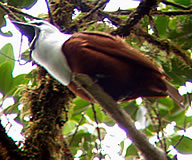
Bell Bird
2. Santa Elena Cloud Forest Reserve (only a few miles from Monteverde) and a little higher was more appealing to us. It was misty, drippy, and very beautiful -- and also offered great bird spotting opportunities. The guides at both reserves are excellent and use sighting scopes (15x optical). We had never seen them before but they are much better for viewing than binoculars AND you can take photos through them!
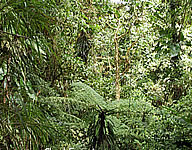
3. The little village of Santa Elena is the base camp for both reserves. It is dusty and somewhat ramshackle (and little more than a block long), but we found it very appealing and would like to go back. Our hotel there (Arco Iris) was great. Beautiful setting, lots of birds. Price was $60 per night. Proprietors were very helpful and efficient in arranging for our guides and transportation to our next destination. There are some very good restaurants in Santa Elena. Our complete meals ranged from about $5 to about $8.
4. The Arenal area is best reached from Santa Elena by a van-boat-van combo that costs $25 per person and takes about 3.5 hours.
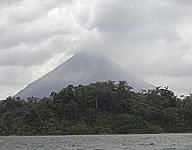
Approachng Arenal by Boat
It is a very scenic ride over incredibly rough unpaved roads. Our lodge (Arenal
Paraiso) was a trip highlight. We had chosen it for its location, as it was
described as perfectly situated for observing the volcano's current night
activity. The direction of this activity had recently changed to favor the
Paraiso but now has changed again out of view from the lodge. But the lodge
has perhaps the best overall volcano views and the grounds are really too
beautiful to describe, surpassing any botanical gardens we have ever seen.
plus - we had an upper level cabin right on the edge of a forest - with perfect
volcano views out our front windows (when the clouds cooperated) and gorgeous
rainforest views out back. We could sit on our deck and watch a parade of
bird life. Judi spotted an armadillo that approached within 20 feet of our
deck and remained for quite a while rooting for something in the ground. She
also spotted a snake climbing a nearby tree -- and got lots of bird pictures.
Like most volcanoes, the top is often occluded by clouds. Luckily for us,
the day we arrived, the entire mountain was visible for most of the afternoon.
And steam and smoke billowed out of the cone for a while. We awoke each morning
to the dramatic calls of howler monkeys and screeching parrots and fell asleep
to the sounds of insects, frogs and birds. At $110 per night our "junior
suite" at the Paraiso was considerably higher than our typical lodging
cost but it was one of those instances where the combination of the setting
and the facilities was worth the extra cost. The price included an excellent
buffet breakfast in a beautiful dining room with, of course, a volcano view.
5. The highlight of our trip was the 4 km trail at the base of Arenal in the national park. We actually began about 1 km outside the park at the Arenal Observatory Lodge. It is another prime location for volcano watching and has a rather special feel to it. We would like to return to Arenal and divide our time between this lodge and the Paraiso. The first part of the volcano trail is like a rain forest. Then you come to the site of the massive 1992 lava flow.
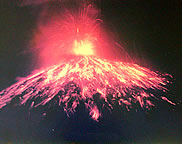
1992 Arenal
Eruption
Photo: Courtesy
Arenal Observatory Museum
From here, you can watch the boulders being ejecting from the volcano tumble down the mountain, leaving a trail of smoke or vapor. You can easily hear the rumbling and reportedly can sometimes feel it! The entire walk can be done in as little as an hour and a half but there is no reason to rush. The middle part of the trail is comprised of crushed lava. For the last part you enter another dense area where some of the trees have 20 or more bromeliads.
6. In the cloud forest region the temperatures were surprisingly cool, averaging around 72°. Arenal was considerably warmer, getting downright hot between 1-3 pm but otherwise quite pleasant. Maximum temp were about 88° to 92° and lows about 68° to 70°. We needed light sweaters most of the time at Santa Elena and even part of the time at Arenal.
7. Our final afternoon and evening were spent in San Jose. As expected, it is not very distinctive but not really unpleasant. We visited the Gold Museum right in the center plaza and found it excellent -- more for the anthropological displays and info than for the gold.
8. We found costs in Costa Rica to be moderate. It is more expensive than Peru and Ecuador. Things are twice the cost of Bolivia, but Bolivia is a super low cost destination.
9. Among the intriguing destinations we learned about for subsequent trips are Tortuguero National Park and Corcovado National Park. Stay tuned.
